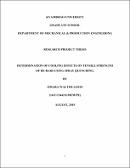| dc.description.abstract | In this study, the tensile strength in carbon steel was achieved under controlled heating and cooling processes. Forty-five samples of billets were used to produce 12 mm, 16 mm and 20 mm of hot-rolled rebar and each rebar was accorded different heat treatment process. The treatment process involved spray quenching by varying the coolant flow rate and coolant temperature at 250C, 350C, and 450 C where the flow rate was controlled using pressure flow meter at 5Kgf/cm2, 10 Kgf/cm2, and 14 Kgf/cm2. The samples for chemical analysis were prepared according to RRM-QA.WI-07and analyzed using the mass spectrometer. The tensile test specimens were prepared according to ASTM E8/E8M-13 and tests were conducted on the Universal Testing Machine. Microstructure analysis was carried out on the specimens obtained from samples using standard methods on a metallurgical microscope(Krussoptronic VOPC93) equipped with a camera of 3.0 megapixels. The analysis of chemical composition revealed that the samples are of low carbon steel with 0.233 wt.% C, 98.3 wt.% Fe, 0.746 wt.% Mn, 0.313 wt.% Si and other alloying elements. The results of the study showed that a pressure flow of 10 Kg f/cm2, and coolant temperature of 35℃, is sufficient to cool a 12 mm, 16 mm and 20 mm rebar and obtain UTS values of 648 Mpa, 604 Mpa& 557 Mpa respectively which falls within 550-650 Mpa, as stipulated in the Ugandan Standard and East African Standard(US & EAS 412-2:2013). The results showed reduced strength for all rebar sizes at low-pressure flow of 5 Kgf/cm2and high coolant temperature of 450C. The microstructure of the specimen showed that a matrix mix of pearlite and ferrite exists in the structure. The more the pearlite in the mixture, the more the hardness with increased strength and reduced percentage elongation, while the more the ferrite in the matrix mix, the less strength it exhibits and increased percentage elongation with less brittleness. The study also showed that for a 12 mm, 16 mm & 20 mm rebar, requires a range from 33.50C to 44.50C at 10 Kgf/cm2 to 14 Kgf/cm2, 35.50C to 44.50C at 6.8 Kgf/cm2 to 13.2 Kgf/cm2 and 260C to 430C at 6.3 Kgf/cm2 to 13.3 Kgf/cm2 respectively to produce UTS of 648-556 Mpa, 554-643 Mpa and 558-645 Mpa respectively. Implementation of these research results will help to reduce rejects of rebars and improve on financial loss of RRM.
Key words; heat treatment, spray quenching, mechanical properties, hot rolled steel bar | en_US |

